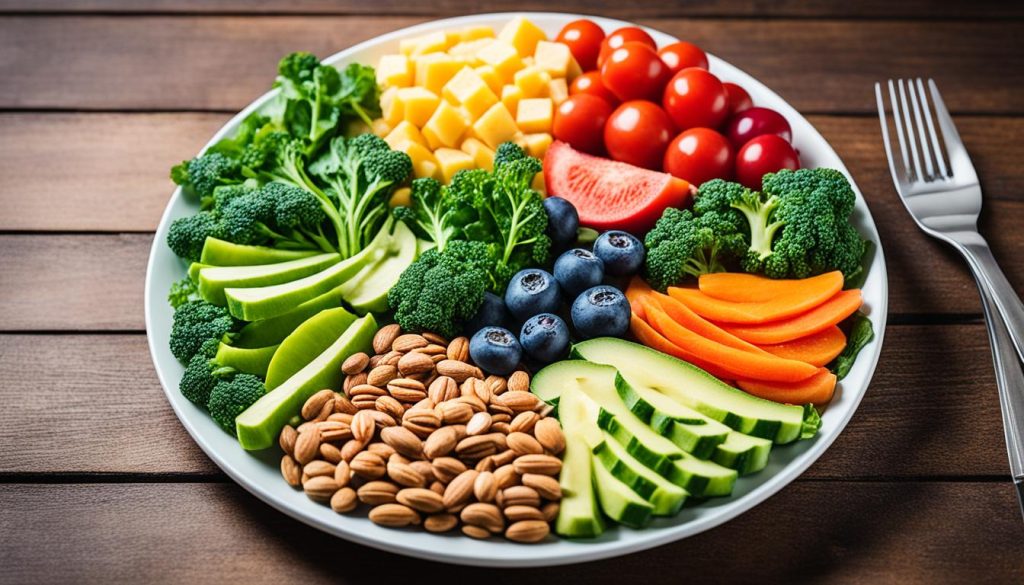A diabetic diet is essential for managing blood sugar levels and promoting overall health for individuals with diabetes. It involves making healthy food choices, controlling portion sizes, and balancing nutrients to achieve optimal blood sugar control.
By following a diabetic diet, individuals can effectively manage their diabetes and reduce the risk of complications such as heart problems and strokes. Implementing a diabetic diet can feel overwhelming at first, but with proper planning and support, it becomes easier to navigate and enjoy delicious and nutritious meals.
What is a Diabetic Diet?
A diabetic diet is a customized approach to managing diabetes through careful food choices and portion control. It is not a restrictive diet that cuts out specific foods but instead focuses on making healthier choices more often and enjoying treats occasionally and in small portions. By following a diabetic diet, individuals can effectively manage their diabetes, control blood sugar levels, and improve overall health.
The primary goal of a diabetic diet is to consume a variety of nutrient-dense foods that promote stable blood sugar levels. This includes incorporating foods such as fruits, vegetables, whole grains, lean proteins, and healthy fats into the daily diet. By choosing these wholesome options, individuals can maximize their nutrition intake and maintain a balanced diet.
It is important to avoid foods labelled as “diabetic” or “suitable for diabetics” as they often do not offer any additional health benefits and may still affect blood sugar levels. Instead, individuals should focus on consuming naturally healthy foods that are part of a balanced diabetic diet.
In addition, it is crucial to limit the consumption of red and processed meats, as they may increase the risk of developing certain health conditions. Highly processed carbs, such as sugary drinks and snacks, should also be limited, as they can cause blood sugar spikes.
When it comes to managing diabetes through diet, it’s essential to remember that each individual’s diabetic diet will vary based on personal preferences, health goals, and current eating habits. Consulting with a healthcare professional or a registered dietitian can provide personalized guidance and help develop a suitable diabetes nutrition plan.
Key Points:
- A diabetic diet focuses on making healthier choices more often.
- There is no need to follow a restrictive diet or cut out specific foods.
- The main focus is on consuming nutrient-dense foods.
- Avoid foods labelled as “diabetic” or “suitable for diabetics”.
- Limit the consumption of red and processed meats and highly processed carbs.
- Each individual’s diabetic diet will vary based on personal preferences, health goals, and current eating habits.
Diabetic Diet for Beginners
Starting a diabetic diet plan can be overwhelming for beginners. However, with a structured plan in place, the transition can be much smoother. It is highly recommended to seek guidance and support from a healthcare team or a registered dietitian who specializes in diabetic meal planning. Their expertise will provide personalized advice tailored to your specific needs.
Successful implementation of a diabetic diet for beginners involves focusing on key aspects such as portion control, carbohydrate counting, and monitoring blood sugar levels. It’s important to understand the impact different foods can have on blood sugar levels and make appropriate substitutions when necessary. By learning how to manage these factors, individuals can effectively navigate their diabetic diet.
Portion control plays a crucial role in managing blood sugar levels. It involves consuming the right amount of food to ensure a balanced carbohydrate intake and prevent blood sugar spikes. Measuring food portions using a food scale or familiarizing oneself with visual cues can be helpful in maintaining portion control.
Carbohydrate counting is another essential skill for diabetics. It involves tracking the carbohydrates consumed in meals and snacks and adjusting insulin doses accordingly. By understanding how various foods affect blood sugar levels, individuals can make informed choices and maintain stable glucose levels throughout the day.
Glucose Monitoring
Monitoring blood sugar levels is essential for individuals with diabetes. Regular blood glucose checks help identify patterns and trends, enabling a better understanding of how specific foods and activities impact blood sugar levels. By using a glucose monitor, individuals can track their progress and make necessary adjustments to their diabetic meal plan.
It’s important to remember that embarking on a diabetic diet is a journey. It may take time to become comfortable with the necessary lifestyle adjustments and understand how your body responds to different foods. The support of healthcare professionals, educational resources, and online communities can make this journey easier, providing tips and advice for the successful management of diabetes through diet.

Diabetic Diet Food List
A healthy diabetic diet consists of a variety of nutrient-dense foods that not only promote stable blood sugar levels but also provide essential nutrients for overall well-being. Incorporating these foods into your meal plan can help you manage your diabetes effectively and maintain a balanced and satisfying diet.
Here are some examples of foods suitable for a diabetic diet:
- Fresh fruits and vegetables: These are low in calories and packed with vitamins, minerals, and dietary fibre. Include a variety of colourful fruits and vegetables in your meals to ensure a range of nutrients.
- Whole grains: Opt for whole grain options such as whole wheat bread, brown rice, quinoa, and oats. These provide complex carbohydrates that are digested slowly, preventing quick spikes in blood sugar levels.
- Lean protein sources: Include lean meats like chicken, turkey, and fish, as well as plant-based protein sources like beans, lentils, and tofu. These options are low in saturated fat and provide essential amino acids.
- Healthy fats: Incorporate sources of healthy fats like avocados, nuts, seeds, and olive oil. These fats can help improve heart health and promote satiety.
- Dairy or dairy alternatives: Choose low-fat or fat-free options such as skim milk, plain Greek yoghurt, and unsweetened almond milk. These provide calcium and other essential nutrients.
It’s important to monitor portion sizes and distribute your food intake throughout the day to maintain stable blood sugar levels. Consult with a registered dietitian for personalized recommendations and guidance on creating a diabetic-friendly diet plan.

Conclusion
Managing diabetes effectively and achieving optimal blood sugar control require following a diabetic diet. Contrary to popular belief, a diabetic diet is not about restrictions; it’s about making healthier food choices, controlling portion sizes, and maintaining a balanced nutrient intake. By embracing this approach, individuals can take charge of their diabetes and enjoy a fulfilling and satisfying lifestyle.
Fortunately, there are plenty of resources available to support individuals in their diabetic diet journey. Diabetes-friendly recipes and meal planning tools can provide inspiration and assistance in creating delicious and nutritious meals. These resources not only make the diabetic diet more accessible but also simplify the process of achieving blood sugar control.
By incorporating the strategies learned through a diabetic diet into daily life, individuals can maintain stable blood sugar levels and reduce the risk of complications associated with diabetes. It’s a journey that requires commitment and support, but the rewards are immeasurable. With the right knowledge and resources, managing diabetes becomes a seamless part of life, enabling individuals to enjoy their favourite meals while keeping their health in check.
FAQs
Is a diabetic diet restrictive?
No, a diabetic diet is not a one-size-fits-all approach and does not involve cutting out specific foods or following a restrictive diet. The main focus is on consuming a variety of nutrient-dense foods, such as fruits, vegetables, whole grains, lean proteins, and healthy fats.
How can beginners start a diabetic diet?
Starting a diabetic diet can be daunting for beginners. It’s important to have a structured plan in place, which may involve working with a healthcare team or a dietitian who can provide personalized guidance and support. Key aspects of a diabetic diet for beginners include portion control, carbohydrate counting, and monitoring blood sugar levels.
What foods are suitable for a diabetic diet?
A diabetic diet food list includes a wide range of nutrient-dense foods that promote stable blood sugar levels and provide essential nutrients. Some examples of foods suitable for a diabetic diet are fruits, vegetables, whole grains, lean proteins, and healthy fats.
How can a diabetic diet help manage diabetes?
Following a diabetic diet is key to managing diabetes effectively and achieving optimal blood sugar control. By making healthier food choices, controlling portion sizes, and maintaining a balanced nutrient intake, individuals can maintain stable blood sugar levels, reduce the risk of complications, and enjoy delicious and nutritious meals.

